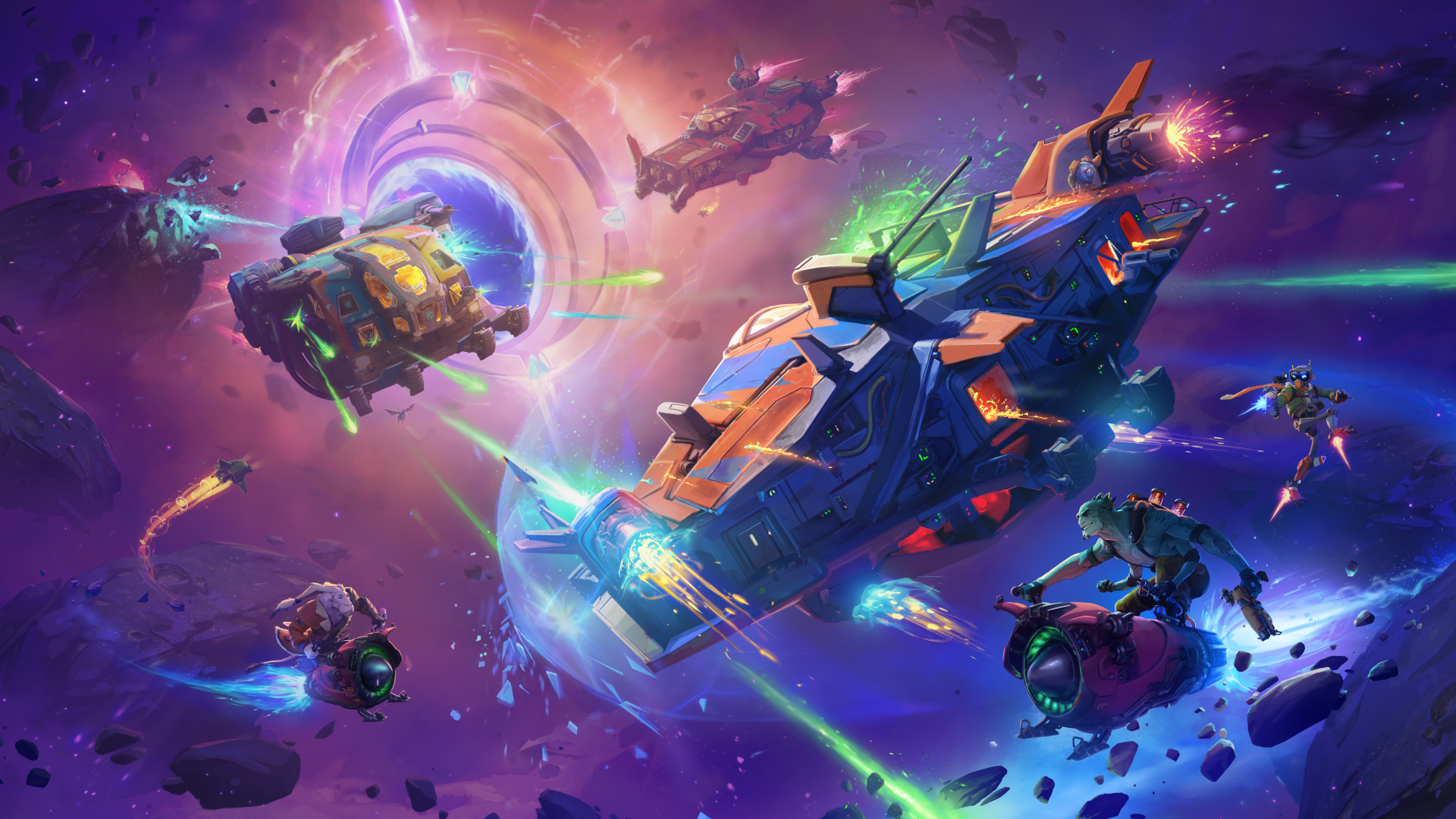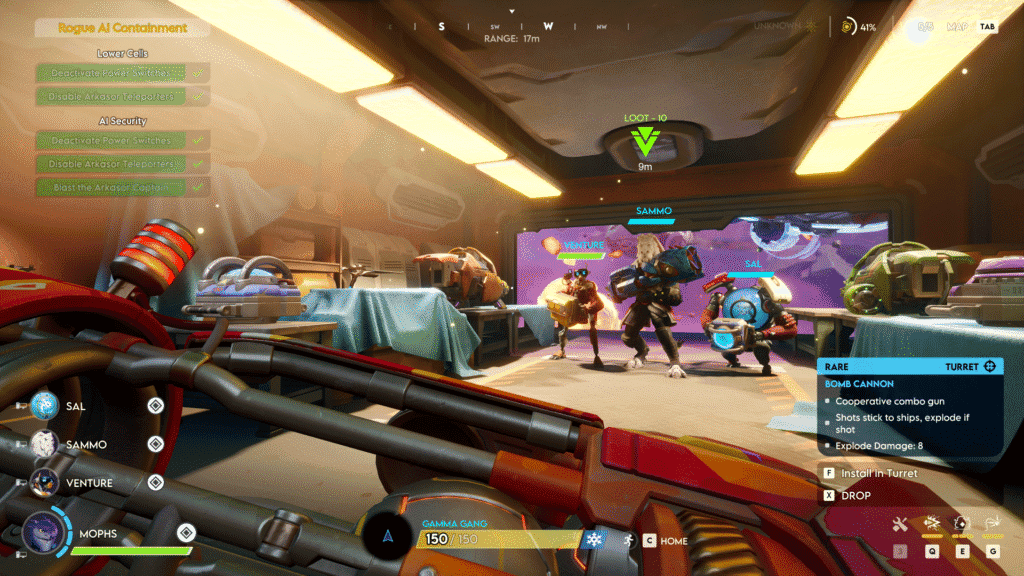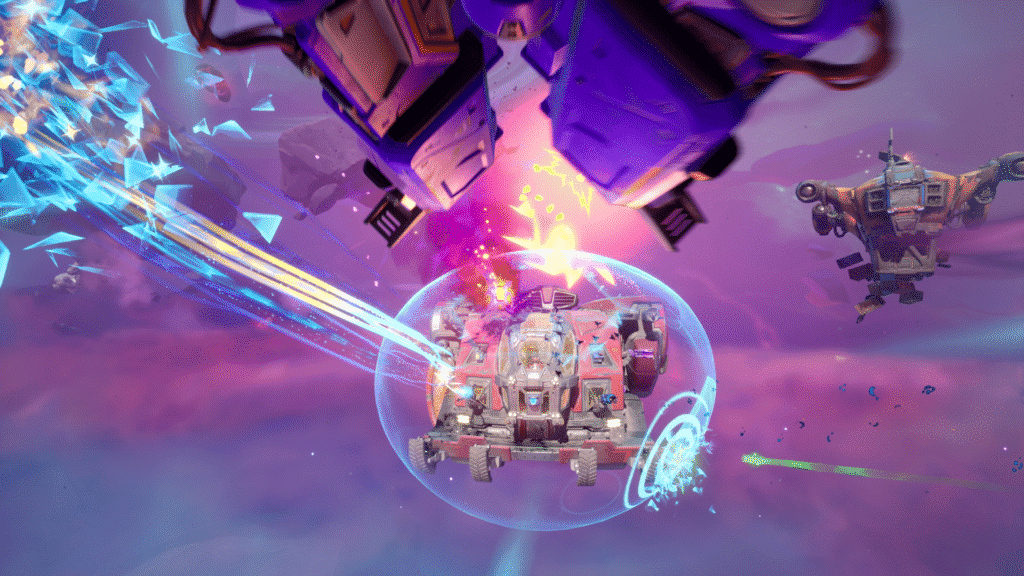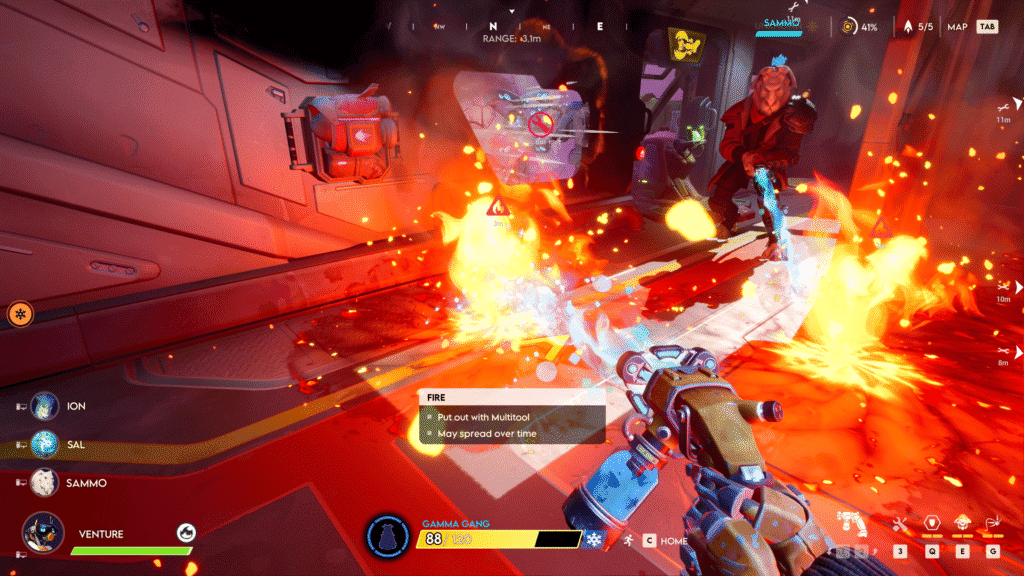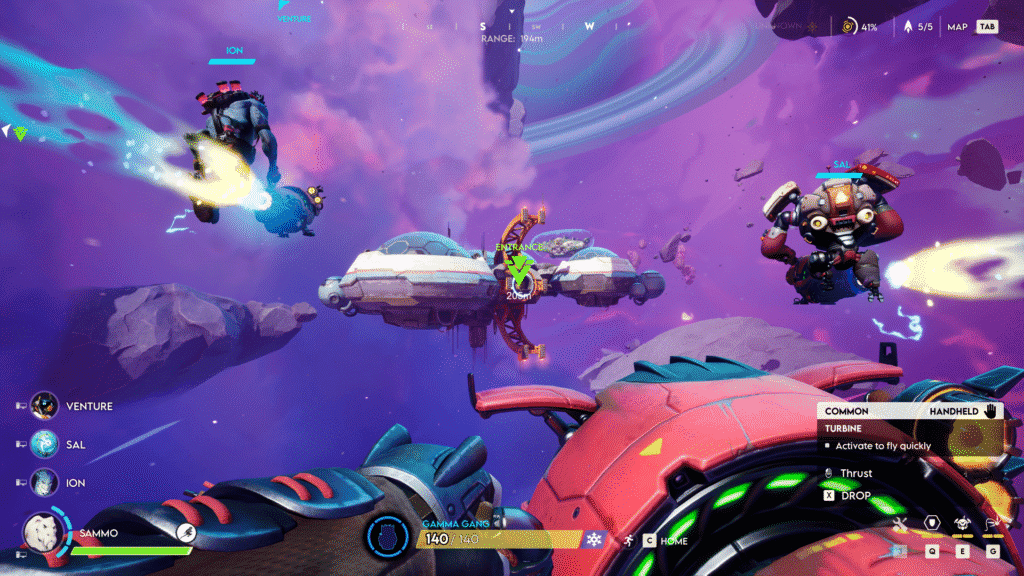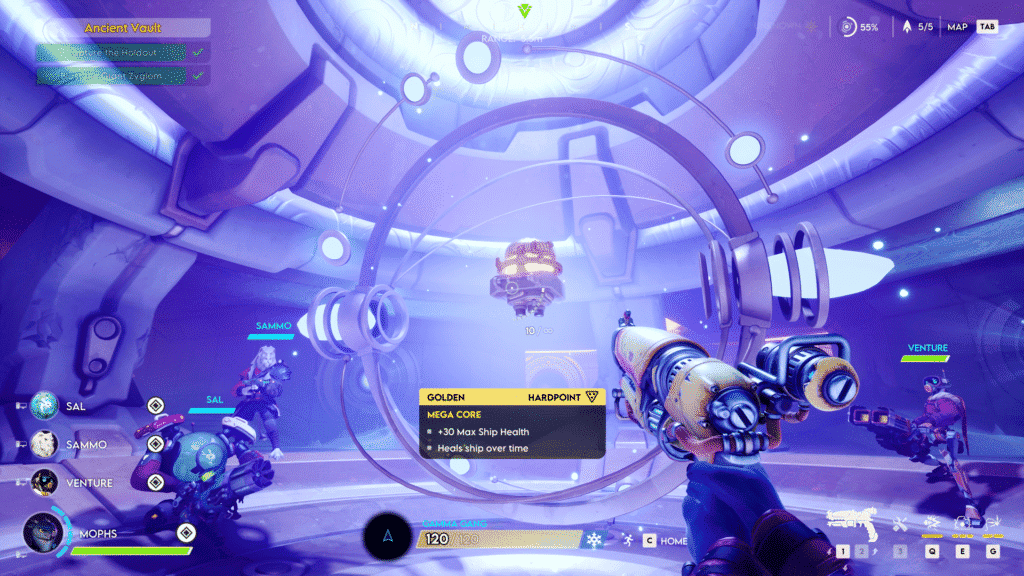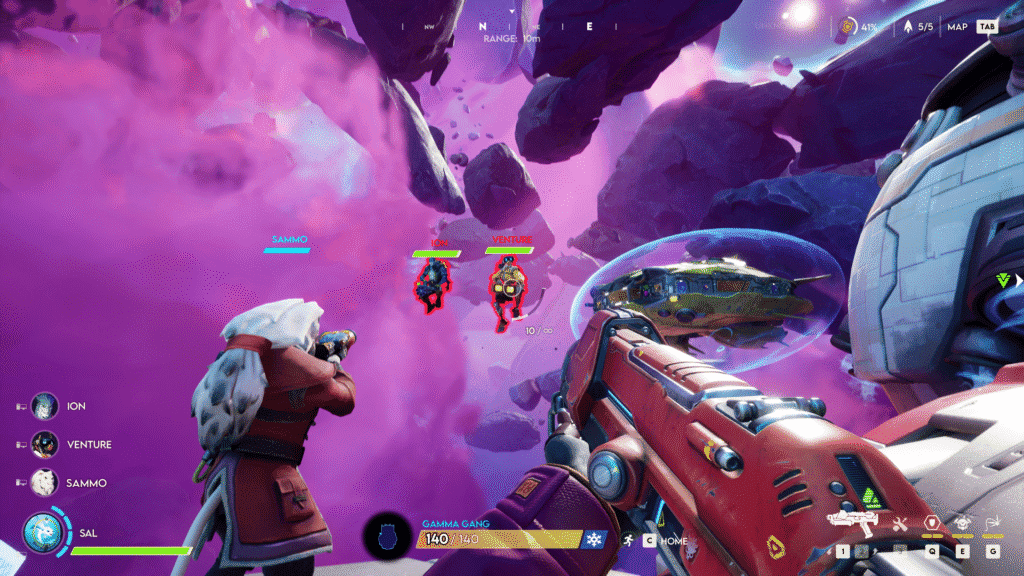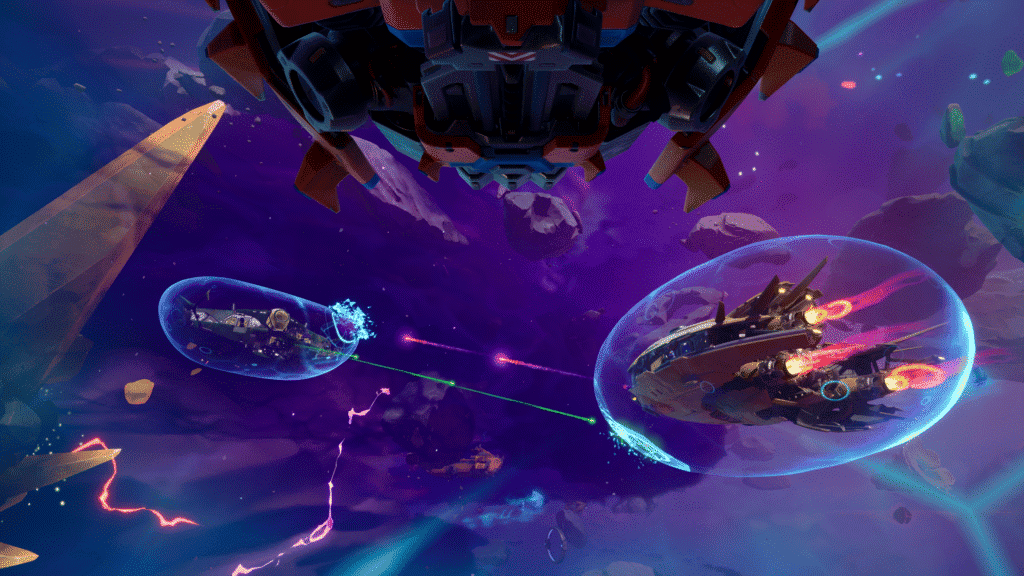Wildgate is one of those games that came out of nowhere and pleasantly surprises you at every turn. This is the debut title from Moonshot Games, an internal studio under the Dreamhaven banner, and it’s clear from the outset that this isn’t just another rote space shooter. Wildgate offers tactical ship-to-ship combat and fast-paced first-person action. After spending many hours navigating getting it space shootouts and and engaging in frantic boarding actions, I can confidently say that this sets a high bar for what a multiplayer sci-fi experience can be. Wildgate is an amalgamation of Sea of Thieves and FTL to be a stellar blend of space dogfights and on-foot mayhem.
Matches begin with crews of players piloting their quasi-customizable starships through expansive, hazard-filled sectors of space to essentially loot up. Five crews will find themselves seeking out destroyed battle ships, mysterious astral trees, and monoliths to complete objectives and obtain RNG loot that will better outfit their ship for combat in the endgame. The goal is to find an artifact, and then bring it through the titular wildgate once it is powered up – like a cleverly disguised extraction shooter. Alternatively, you just need to be the last surviving crew in order to win. Though in either scenario, that’s something that’s easier said than done. First you have to survive long enough, and hopefully find it. Then there’s the possibility of running into another crew and deciding to fight to the death or retreating to heal their wounds. Lastly, once a team has the artifact, everyone in the match is notified of its location at all times, leaving
At the heart of Wildgate‘s appeal lies its ingenious gameplay loop, seamlessly weaving together two distinct, yet complementary, gameplay styles. The ship combat here is surprisingly deep, requiring you learn optimal distances of each weapon and when to engage. Each vessel feels distinct, from the nimble scout ships that dart through asteroid fields to the lumbering, heavily armed dreadnoughts that can soak up punishment. Maneuvering feels weighty yet responsive, and the tactical depth comes from managing energy distribution between shields, weapons, and engines, alongside precise aiming with various projectile and beam weapons. It’s a dance of evasion, positioning, and concentrated fire that rewards teamwork and strategic thinking. Wildgate‘s gameplay is two halves of a thrilling whole.
But Wildgate truly distinguishes itself when the inevitable happens: one ship cripples another. This isn’t just a kill; it’s an invitation. At any time a ship can be boarded, some ships are more secure than others, but it can be done. Players can venture out into space, provided they hav enough oxygen to survive the trip, and begin to steal weapons or equipment, or even overload their core to blow-up the ship entirely. As a crew, you have to be ready to transition from open-space dogfighting to intense, close-quarters first-person shooter combat within the confines of a vessel being attacked. Things become frantic quickly as communication is paramount in prioritizing targets, putting out fires, repairing a window or door, and whether to flee or not.
The on-foot combat is smooth and responsive where weapons have a satisfying punch, and the various character abilities add layers of tactical depth. This dual-layered combat system ensures that no two matches feel quite the same, constantly forcing players to adapt and switch gears. Along the way you’ll have to manage resources like ice and ammo. Ice is used to cool your reactor once it takes damage, and ammo is used to get into dogfights. These two resources are littered everywhere, but takes concerted efforts from your team in order to obtain. The sheer thrill of crippling an enemy ship, only to then lead a boarding party that systematically dismantles their crew from the inside out, is a feeling few other games can replicate. There’s a distinct learning curve to Wildgate that I still haven’t mastered. And so this really isn’t a pick-up and play game, at least in the sense that you’ll immediately find yourself victorious, though that’s something that comes with practice and in time.
Wildgate‘s replayability stems directly from its dynamic gameplay and the sheer variety of ways a match can unfold. With multiple ship types, diverse weapon loadouts, and distinct character roles, there’s ample room for experimentation and strategic team composition. The procedural generation of environmental hazards and artifact locations within each map also adds a layer of unpredictability, preventing matches from feeling stale.
This is a multiplayer-only game, either in PVP or against the AI. There are single-player modes, but they are reserved for the shooting range and tutorial only, so not really an offline component you can truly play. The servers have held up really well during and post-launch. I will say that when you are assembling a squad, there is no “ready up” button, and so a lot of time can accidentally be wasted by the party leader not throwing everyone into matchmaking. And on that point, the matchmaking is fast, and can even be done cross-platform, but it does not do any skill-based matchmaking. Before a match begins, everyone is thrown into a lobby as it assembles the rest of the crews. And often it seems everyone is present, but an arbitrary countdown still occurs. This feels like it could be sped up, especially since players cannot modify their loadout at this stage. It just feels like it takes too long to get into a match.
There are seven prospectors to play as, each of them different with different abilities in stats. They are somewhat class-based, with raider, explorer, boarder, ship defender, and engineer as their designation. That’s five classes across seven characters, so not exactly an even spread, I’m curious if this roster might grow to fit this a bit better. For instance, I find myself gravitating towards the robot that doesn’t require oxygen, whereas my friends plays as guy with four arms that reloads weapon not used and has a strong melee attack. Whichever you choose, there is not one objectively better than the other, it fits in with how you want to play.
You will define a loadout prior to matchmaking, selecting two weapons, two pieces of equipment, and what your preferred ship is. The nine weapons are varied from a pistol that shoots micro-missiles, a beam rifle, a goo gun, and other sci-fi weaponry where again, none feel objectively stronger than the other. This also extends to the thirteen equipment items like drones, drill charges, and foam cans that can be thrown to put out distant fires on the ship. Though my personal favorite is the teleport reloader, in that when you teleport back to your ship, all your weapons and equipment items are reloaded and restocked. Everything really feels balanced here, and that’s a rare feat.
There are four ships in the game, each one of them is formidable in their own way and server different purposes. The Hunter is the default gunship you start with, but is really wide and hard to navigate tight spaces with. So really any other ship will be more enjoyable to use. Both the Bastion, a ship focused in security and minimal entry points and the Privateer, a battle ship are far better options. Though you shouldn’t count out the Scout, it’s a really fast ship that is great for hit-and-run attacks, where no other ship can catch you. It’s impossible to know which ship is best before a match, but learning each ship for their layouts, strengths, and weaknesses are important.
You will find a “battle pass” of sorts in the game, called rewards, but it’s all free. Simply earning experience puts forth progression into these reward tracks. There is a reward tier for each character, and progressing in each of them unlocks items that can be used by anyone. The best item to unlock from each character is the third thing you’ll unlock. You can switch tracks at any time, so it’s best to play each reward track up until level three, and switch until you’ve unlocked them. Everything after that is all cosmetics. There is an in-game store that charges you real money for in-game items, but the items found in the store today are purely cosmetic and nothing more.
Visually, Wildgate is a treat. Moonshot Games has opted for a vibrant, slightly stylized aesthetic that perfectly captures the “wild” nature of its cosmic setting. Explosions bloom across the screen with satisfying particle effects, weapon fire streaks through space with distinct visual signatures, and the environmental hazards—be it the blinding glare of a nearby star or the engines burning of a ship, either are rendered with impressive fidelity and crispness. The ship designs are imaginative, blending utilitarian sci-fi with a dash of rugged individualism, and the character models, while not hyper-realistic, are expressive and well-animated. Performance for me was excellent, maintaining over 100fps even during the most chaotic multi-ship engagements.
My PC Specs:
– Linux (6.15.6-2-cachyos)
– Intel Core i9 13900K @ 5.8GHz
– ASUS ROG RYUJIN II 360 ARGB AIO Liquid CPU Cooler
– G.SKILL TRIDENT Z5 6000MHZ 64GB (32×2) DDR5 RAM
– ASUS ROG Strix GeForce RTX 4080 16GB GDDR6X
– WD_BLACK SN850X M.2 (4 TB)
– LG UltraGear 34GP950B-G (21:9 Ultrawide @ 3440×1440)
Wildgate is a bold and ambitious undertaking that succeeds at what it sets out to do. It’s something that demands teamwork, rewards tactical thinking, and delivers exhilarating moments of high-stakes action throughout every match. You won’t find this to be overwrought with monetization or collaborations, it’s a simple game that really does everything right. Moonshot Games has ensured that this is a multiplayer experience that feels fresh and exciting. The core of Wildgate is incredibly strong, and win or lose you’re bound to have a good time in the untamed cosmos.
A Steam code was provided by the publisher for review purposes
